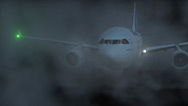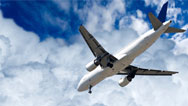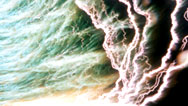When Lightning Strikes Aircraft
- By David Levin
- Posted 02.16.11
- NOVA
After the crash of Air France Flight 447 in 2009, widespread debate appeared on the Internet about whether a lightning strike could have brought the plane down. Just how dangerous is lightning to an aircraft in flight?
 Listen
Listen
An aviation safety expert and a veteran airline pilot weigh in on the effects of lightning strikes during flight.
Transcript
When Lightning Strikes Aircraft
Posted February 16, 2011
DAVID LEVIN: You're listening to a NOVA podcast. I'm David Levin.
In June 2009, Air France Flight 447 plunged into the Atlantic Ocean off the coast of Brazil, taking all 228 lives aboard. The plane's in-flight recorders were never found, and the cause of the crash is still a mystery. A lot of speculation popped up on the Internet about lightning being the culprit. But just how dangerous is lightning to a moving airplane?
JOHN COX: Aircraft are struck by lightning far more often than most people realize. I don't know of a professional pilot that has been in an aircraft that hasn't been struck by lightning. It happens.
DAVID LEVIN: John Cox is an aviation safety consultant in Washington, DC. He says that although lightning might cause a bright flash and a loud bang, it won't do much damage.
JOHN COX: It's frightening to the passengers, the aircraft will require some maintenance, so pilots do everything they can to avoid being struck by lightning. But is it a safety risk, a flight hazard? No, it's not. The aircraft's actually designed for it. We have routinely shown that the aircraft are capable of sustaining very heavy, very large lightning strikes and not having it be a problem.
DAVID LEVIN: Cox says the last crash caused by lightning happened in the mid-1960s. In that case, the fuel tank of an Iranian Air Force 747 exploded when it was hit by lightning during landing. Today, though, Cox says that government regulations and aircraft design are very different, so he's doubtful it could happen again.
JOHN COX: There's certification requirements based on longstanding and proven rules through the FAA that deal with the requirement that the aircraft be able to sustain a lightning strike and not have it adversely affected. The effect on the airplane is minimal. You get some pitting, some burning in the skin and some things like that, and it's dissipated.
MARTIN ALDER: Yeah, yeah. I mean, airplanes are hit by lightning fairly frequently, and we don't have airplanes raining out of the sky because of lightning strikes.
DAVID LEVIN: That's Martin Alder. He spent more than 20 years as a captain for British Airways, and is one of the many pilots whose planes have been struck by lightning in flight.
MARTIN ALDER: It was daytime. And in front of me I suddenly saw this dancing light, and the next—within a split-second there was a bang of the lightning hitting the aircraft, no, no change to any of the instruments or anything. A quick cross-check between two of us revealed that we couldn't see any adverse effect at all. We were due to land, we were in the process of preparing for the approach, we continued on and did the approach and landed. But, you know, for a few moments, I'm just like any other human being. If there's a big loud bang not very far from where you're sitting, I'm going to jump.
DAVID LEVIN: Other than being startled by a lightning strike, Alder says he's not too concerned about them.
MARTIN ALDER: The designers have been doing their job for the last, best part of a hundred years, dealing with this. And the, the experience in the industry has been put together to design the aircraft in such a way as to deal with it.
DAVID LEVIN: When lightning does strike a plane, it doesn't really penetrate the skin. Instead, the charge moves around the outside of the aircraft.
MARTIN ALDER: And the aircraft itself acts as a big conductor, so the skin of the airplane is metal and the lightning goes through that metal, it's the least resistance. And then the discharge from the aircraft is through the pointed parts, the wingtips, the tail.
DAVID LEVIN: Take a look at the wingtips next time you fly. You'll probably see tiny spikes or wires sticking out of the rear edge. Those are called "static wicks," and they help channel lightning away from the airplane.
MARTIN ALDER: If it's a really big one it might overload those and they'll burn off and that's what they're designed to do, they burn away rather than damaging the structure.
DAVID LEVIN: But no matter how well-designed planes are, the best defense against lightning is the judgement of pilots who stay out of extreme weather.
MARTIN ALDER: In terms of thunderstorms and lightning, prevention is always better than cure, so our first option is not to go there. Pilots, remember, are at the front end of the airplane, the first people to meet any accident. We have a great incentive not to meet accidents. No, a pilot wouldn't willingly fly through a thunderstorm if they could help it.
Credits
Audio
- Produced by
- David Levin
Image
- (aircraft with lightning)
- © Erik Simonsen
Related Links
-

Crash of Flight 447
Forensic investigators reconstruct the final moments of the Air France disaster.
-

Better Forecasts for Aircraft
Could new weather forecasting technology make flights over oceans safer?
-

Lightning
Experts still aren't sure what triggers lightning, but they suspect cosmic rays from outer space.
You need the Flash Player plug-in to view this content.

